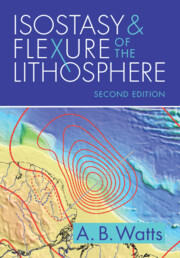Book contents
- Isostasy and Flexure of the Lithosphere
- Isostasy and Flexure of the Lithosphere
- Copyright page
- Dedication
- Contents
- Preface to the Second Edition
- Preface to the First Edition
- Acknowledgements
- Notation
- 1 The Development of the Concept of Isostasy
- 2 Isostasy and Flexure of the Lithosphere
- 3 Theory of Elastic Plates
- 4 Geological Examples of the Flexure Model of Isostasy
- 5 Isostatic Response Functions
- 6 Isostasy and the Physical Nature of the Lithosphere
- 7 Isostasy and the Origin of Geological Features in the Continents and Oceans
- 8 Isostasy and the Terrestrial Planets
- References
- Index
1 - The Development of the Concept of Isostasy
Published online by Cambridge University Press: 28 September 2023
- Isostasy and Flexure of the Lithosphere
- Isostasy and Flexure of the Lithosphere
- Copyright page
- Dedication
- Contents
- Preface to the Second Edition
- Preface to the First Edition
- Acknowledgements
- Notation
- 1 The Development of the Concept of Isostasy
- 2 Isostasy and Flexure of the Lithosphere
- 3 Theory of Elastic Plates
- 4 Geological Examples of the Flexure Model of Isostasy
- 5 Isostatic Response Functions
- 6 Isostasy and the Physical Nature of the Lithosphere
- 7 Isostasy and the Origin of Geological Features in the Continents and Oceans
- 8 Isostasy and the Terrestrial Planets
- References
- Index
Summary
The idea that loads on the Earth’s surface may be regionally rather than locally supported can be traced back to Gilbert and Barrell’s work at the turn of the twentieth century. Their work was carried out at a time when the U.S. Coast and Geodetic Survey promoted the use of local, rather than regional, models of isostasy. The geodesists, with the exception of Putnam, showed that regional models of isostasy were not required to explain geodetic data.
While Gilbert perhaps was influenced by the geodesists, Barrell was not. Barrell challenged the geodesists’ conclusions concerning local models of isostasy, invoking instead the idea that topography was supported regionally by the lateral strength of the lithosphere. Following Barrell’s death, there was a vacuum, and the new ideas of regional isostasy gradually gave way again to local models of isostasy, which continued to be championed by the geodesists, notably Hayford, Bowie and Heiskanen
The history thereafter is a punctuated one with “bursts” of activity followed by long periods of quiet. The work centred on the activities of a few individuals: Vening Meinesz, Gunn and Walcott. Vening Meinesz and Gunn were contemporaries but there is little evidence of any contact between them.
- Type
- Chapter
- Information
- Isostasy and Flexure of the Lithosphere , pp. 1 - 53Publisher: Cambridge University PressPrint publication year: 2023



